With the help of trusted local residents, Sebastian Cresswell-Turner discovers that there’s more to Sardinia than the North Sardinia coast…
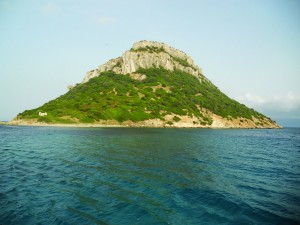
Whether it is laziness, the passing of the years, or perhaps the late onset of common sense, I don’t know, but whenever I go somewhere new, I like, nowadays, to place myself firmly in the hands of local residents so as to get the most out of the limited time available. Seldom did this approach pay off so well as on a recent visit to Sardinia, when, in the course of a few short days, I enjoyed the best that the island has to offer without once having to worry about anything. The best out-of-the-way restaurants; the quietest and most secluded beaches; the most exotic mountain scenery – all arranged. Why do it any other way?
The Hotel Gabbiano Azzurro lies just to the south of the North Sardinia coast, the name given to the strip of coast which was famously developed by the Aga Khan from the 1950s onwards, and which is now synonymous with sun, sea, and the super-rich. This hotel was just the sort of family-run place we were after – a friendly base from which to explore the island, but without the frightening price-tag attached to anywhere further north. Over an aperitif on the main terrace, the owner’s wife, Antonella Datome, assured us that a driver had been arranged, and invited us to join her for dinner in the restaurant of the hotel. So only a few hours after leaving England we were seated at a large linen-topped table right by the sea, eating freshly-caught lobster washed down by a delicious local wine called Anastasìa – a wine which, I immediately decided, I would stick to wherever possible.
What Antonella had not told us about the driver, whose name was Ninni, was that he was the spitting image of Jack Lemmon, with charm to match, and that he spoke perfect English too; as we climbed into his large 4×4 early the next day, I knew that we were in the right hands.
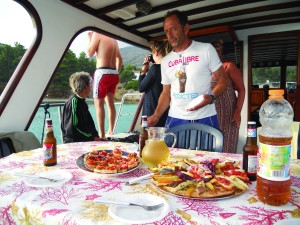
Soon after, we were in a secluded bay preparing for the two-mile hike up to the top of the promontory of Capo Figari. Normally, this would be done under a clear blue sky with a backdrop of Mediterranean scrub consisting of juniper trees, wild olive trees, and myrtle. But today the weather was overcast and there had been a fire on the mountainside, and so, to the throbbing accompaniment of countless cicadas, we set off uphill through charred landscape and were soon shrouded in fog. It was eerie, and rather beautiful. A few hours later, the fog lifted and on our way back down we made the short detour to a cemetery lying on the bare mountain with graves covered in piles of stones. This lonely, evocative place, like something out of a spaghetti western, is called Il Cimitero degli Inglesi for the simple reason that the one grave with a name on it belongs to an English sailor who was drowned hereabouts 100 years ago.
Back on the beach of the bay, Ninni’s wife was waiting for us with a picnic, and then it was time for a swim, followed by an inspection of the other beaches, on one of which we sat down at a bar where I ordered a popular Italian drink called Aperol, which tastes rather like a good Campari. There is, however, no getting away from it – on a beach I become restless after five minutes, Aperol or no Aperol. I prefer to be in boats than on beaches.
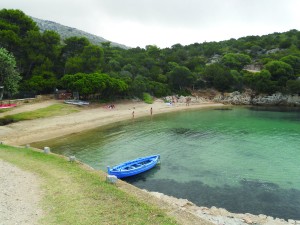
It was therefore lucky that Antonella had arranged for us to go on a late-afternoon trip with a colourful local character who turned up bare-foot in the lobby, I suspect mainly to tease her. He calls himself ‘Marco del Mare’ (Marco of the Sea) and he takes you out in his boat to a spot where there is a family of dolphins, and here he dives into the sea and swims with them. Anyone who wants can jump in too. Later, we moored in the same bay that Ninni had taken us to that morning, and Marco produced a large plate of tomato bruschetta, a flask of local wine and a few bottles of the local beer called Ichnusa. We all sat there, enchanted by the silence and the gentle rocking of the boat; and as we made our way back over the water, the sun sank behind the hills, a large mythical ball of fire.
The next morning we were back in the hands of Ninni, heading westwards through forests of cork trees towards the mountains in the centre of the island. Thrilled at the prospect of being able to put his 4×4 through its paces on demanding white roads where few of his clients ask to go, he explained that the real Sardinia lies inland, and that historically the Sardinians did not occupy the coast, but sought refuge in the uplands. Thus the true gastronomic tradition of the island is a mountain one; and for lunch he had arranged to take us to a remote but excellent restaurant specialising in typical Sardinian food.
But first, leaving the tarmac road, we drove into the huge wild expanse of Monte Limbara. Straight away I was thankful that we were not in a vehicle I was responsible for, because at every bend it became more apparent that if you come here in a hire-car, you can expect to be hit for a very large sum of money in damages when you return it. But this was Ninni’s car, and he was in his element. Twisting and turning, we drove upwards through lush green woods and past sparkling wayside streams, and then emerged into a strange wild landscape below which the most stupendous views stretched into the very farthest distance. It was a land of the giants, and I had never seen anything like it before; a land of rich prehistoric vegetation littered with huge granite boulders, as though the gods of old had just finished some epic battle. And everywhere, the most complete silence. At the high point of Punta Balistreri, surrounded by fields of yellow gorse, we felt as though we were on the top of the world.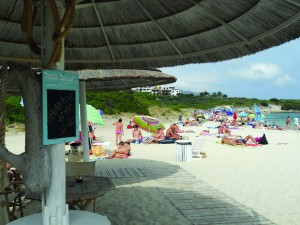
The descent back into the plains below might have been an anticlimax, but Ninni’s choice of restaurant meant that it was not. On the terrace of the Hotel-Restaurant Funtana Abbas, from where we had a pristine view over the man-made Lago di Liscia, I ate one of the best meals I have had in Italy: one plate after another of Sardinian specialities, all cooked by a former champion lightweight boxer called Mario. Again, the silence was absolute. “La sera non si sente nemmeno una mosca,” said Mario – in the evening here, you don’t even hear a fly.
Lunch over, we drove round to the other side of the lake to see an olive tree reputed to be the most ancient in Europe and to marvel that, at 4,000 years of age, it was already 1,000 years old when Homer was born. After this, the venerable exhibits in the local Galluras museum in Luras seemed almost ridiculously modern. Here, the most famous item is the hammer used until the 1920s by the so-called femina agabbadòra – a female figure who was called out to put an end to the suffering of terminally ill patients by administering a sharp knock on the weakest point of the cranium.
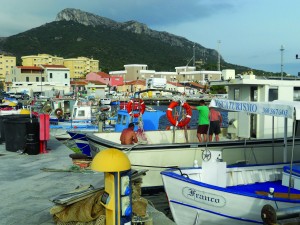 Finally, it was time to go home, again through huge forests of cork trees stretching into the distance. Suitably enough, Ninni put on a CD of songs by a group that was famous in the 1960s called I Giganti – ‘the Giants’. And the next day, as we sadly packed our bags, I reflected that according to legend, this island was once inhabited by a race of giants. Who else could have thrown around all those granite boulders at the top of the mountains?
Finally, it was time to go home, again through huge forests of cork trees stretching into the distance. Suitably enough, Ninni put on a CD of songs by a group that was famous in the 1960s called I Giganti – ‘the Giants’. And the next day, as we sadly packed our bags, I reflected that according to legend, this island was once inhabited by a race of giants. Who else could have thrown around all those granite boulders at the top of the mountains?
Photography © Sebastian Cresswell-Turner
